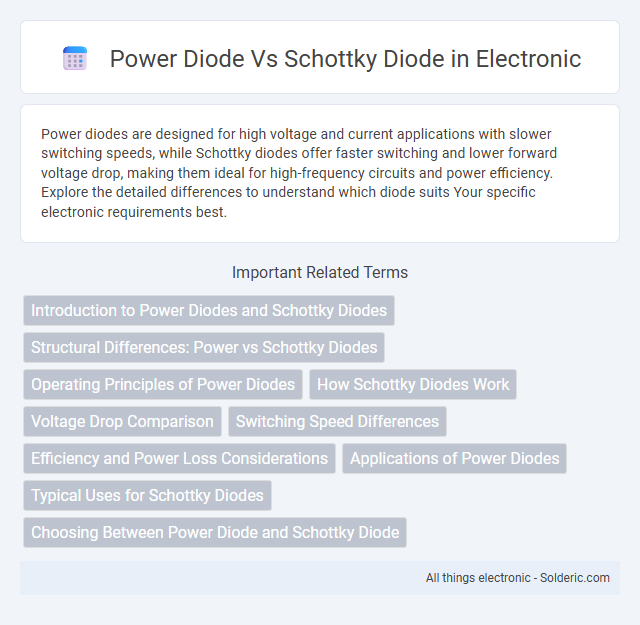Power diodes are designed for high voltage and current applications with slower switching speeds, while Schottky diodes offer faster switching and lower forward voltage drop, making them ideal for high-frequency circuits and power efficiency. Explore the detailed differences to understand which diode suits Your specific electronic requirements best.
Comparison Table
| Feature | Power Diode | Schottky Diode |
|---|---|---|
| Construction | PN junction semiconductor | Metal-semiconductor junction |
| Forward Voltage Drop | Typically 0.7 - 1.1 V | Low, typically 0.2 - 0.3 V |
| Switching Speed | Slower switching speed | Fast switching speed |
| Reverse Recovery Time | High reverse recovery time | Very low reverse recovery time |
| Reverse Leakage Current | Low leakage current | Higher leakage current |
| Applications | High voltage rectification, power supplies, inverters | High-frequency circuits, power rectification with fast switching |
| Maximum Voltage | Up to several kV | Lower voltage ratings, typically up to few hundred volts |
| Maximum Current | High current handling capability | Moderate to high current ratings |
Introduction to Power Diodes and Schottky Diodes
Power diodes are semiconductor devices designed to handle high voltage and current, commonly used in rectification and power conversion applications. Schottky diodes, characterized by their low forward voltage drop and fast switching speed, rely on a metal-semiconductor junction rather than a p-n junction. Understanding these key differences helps you select the optimal diode type for your high-efficiency power management circuits.
Structural Differences: Power vs Schottky Diodes
Power diodes feature a PN junction with a thick depletion region designed for high voltage and current handling, enabling efficient rectification in heavy-duty applications. Schottky diodes have a metal-semiconductor junction with minimal junction capacitance, resulting in faster switching speeds and lower forward voltage drops. The structural variation between the PN junction and metal-semiconductor interface defines their distinct electrical characteristics and application suitability.
Operating Principles of Power Diodes
Power diodes operate by allowing current to flow in one direction through a PN junction, utilizing the junction's ability to withstand high voltage and current, making them suitable for rectification in power applications. Schottky diodes, on the other hand, rely on a metal-semiconductor junction instead of a PN junction, resulting in faster switching speeds and lower forward voltage drops. Your choice between power diodes and Schottky diodes depends on the need for efficiency and speed versus voltage and current handling capabilities.
How Schottky Diodes Work
Schottky diodes operate using a metal-semiconductor junction, which creates a low forward voltage drop and fast switching capabilities compared to power diodes that use a p-n junction. This metal-semiconductor interface significantly reduces the charge storage time, enabling Schottky diodes to switch off rapidly and maintain high efficiency in high-frequency applications. Their unique construction results in minimal reverse recovery time and lower forward voltage, making them ideal for power rectification in switching power supplies and RF circuits.
Voltage Drop Comparison
Power diodes typically exhibit a forward voltage drop ranging from 0.7 to 1.1 volts, which results in higher power dissipation compared to Schottky diodes. Schottky diodes feature a lower forward voltage drop, usually between 0.15 and 0.45 volts, enabling improved efficiency in low-voltage and high-speed switching applications. The reduced voltage drop in Schottky diodes minimizes conduction losses, making them suitable for power-sensitive circuits and high-frequency rectification.
Switching Speed Differences
Power diodes typically have slower switching speeds due to their thicker semiconductor layers and higher charge storage, causing increased reverse recovery time. Schottky diodes feature a metal-semiconductor junction that allows almost instantaneous switching with minimal reverse recovery, making them ideal for high-frequency applications. Your choice between the two hinges on whether fast switching or high voltage handling is more critical for your circuit design.
Efficiency and Power Loss Considerations
Power diodes and Schottky diodes differ significantly in efficiency and power loss characteristics, with Schottky diodes offering lower forward voltage drop (typically 0.2 to 0.4 volts) compared to power diodes (typically 0.7 volts or higher), resulting in reduced conduction losses and improved efficiency in high-frequency switching applications. Schottky diodes also exhibit faster switching speeds and lower reverse recovery times, minimizing power dissipation and heat generation under rapid switching conditions. When optimizing your circuit for energy efficiency and minimizing power loss, selecting a Schottky diode can enhance performance, especially in power supplies and RF systems.
Applications of Power Diodes
Power diodes are widely used in high-voltage rectification, such as in power supplies, motor drives, and induction heating systems due to their ability to handle large current and voltage ratings. They are essential in energy conversion applications like AC-DC power conversion in industrial equipment and uninterruptible power supplies (UPS). Unlike Schottky diodes, which excel in high-speed switching and low forward voltage drop applications, power diodes are preferred where robustness and high surge current capability are critical.
Typical Uses for Schottky Diodes
Schottky diodes are commonly used in high-speed switching applications, such as power rectifiers in low-voltage power supplies and RF applications due to their low forward voltage drop and fast recovery time. Their efficiency in reducing power loss makes them ideal for battery-powered devices and voltage clamping in circuits. You can often find Schottky diodes in automotive electronics, solar cells, and switching power regulators, where minimizing heat generation and maximizing response speed are essential.
Choosing Between Power Diode and Schottky Diode
Selecting between a power diode and a Schottky diode depends largely on switching speed and forward voltage requirements; Schottky diodes offer faster switching and lower forward voltage drop, making them ideal for high-frequency applications and power-sensitive circuits. Power diodes, with higher reverse voltage ratings and greater current carrying capability, excel in high-power rectification where efficiency and thermal performance are critical. Evaluating factors such as reverse recovery time, forward voltage, and maximum voltage/current ratings ensures optimal diode selection for specific electronic circuit needs.
Power diode vs Schottky diode Infographic

 solderic.com
solderic.com